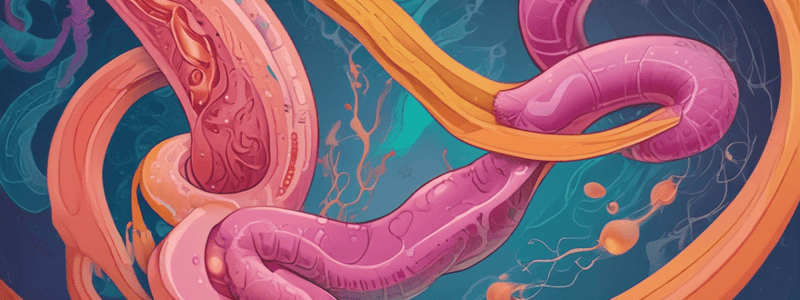Podcast
Questions and Answers
Acid damage to the stomach mucosa is due to an imbalance between ________ defenses and acidic environment.
Acid damage to the stomach mucosa is due to an imbalance between ________ defenses and acidic environment.
mucosal
The ________ layer produced by foveolar cells is part of the stomach's defense against acidic damage.
The ________ layer produced by foveolar cells is part of the stomach's defense against acidic damage.
mucin
Severe burn can lead to ________ ulcer due to hypovolemia, which decreases blood supply.
Severe burn can lead to ________ ulcer due to hypovolemia, which decreases blood supply.
Curling
Chronic inflammation of the stomach mucosa is known as ________ gastritis.
Chronic inflammation of the stomach mucosa is known as ________ gastritis.
Increased intracranial pressure can lead to ________ ulcer due to increased acid production.
Increased intracranial pressure can lead to ________ ulcer due to increased acid production.
NSAIDs can contribute to acid damage by decreasing ________ production.
NSAIDs can contribute to acid damage by decreasing ________ production.
Chronic autoimmune gastritis is due to autoimmune destruction of gastric ______ cells, which are located in the stomach body and fundus.
Chronic autoimmune gastritis is due to autoimmune destruction of gastric ______ cells, which are located in the stomach body and fundus.
Chronic H pylori gastritis is due to H pylori-induced ______ and chronic inflammation.
Chronic H pylori gastritis is due to H pylori-induced ______ and chronic inflammation.
In chronic autoimmune gastritis, atrophy of ______ with intestinal metaplasia is a clinical feature.
In chronic autoimmune gastritis, atrophy of ______ with intestinal metaplasia is a clinical feature.
Increased risk for ______ anemia is a clinical feature of chronic autoimmune gastritis due to lack of intrinsic factor.
Increased risk for ______ anemia is a clinical feature of chronic autoimmune gastritis due to lack of intrinsic factor.
H pylori ureases and proteases along with inflammation weaken ______ defenses in chronic H pylori gastritis.
H pylori ureases and proteases along with inflammation weaken ______ defenses in chronic H pylori gastritis.
Increased risk for gastric ______ is a complication of chronic H pylori gastritis.
Increased risk for gastric ______ is a complication of chronic H pylori gastritis.
The intestinal type of gastric carcinoma presents as a large, irregular ______ with heaped up margins.
The intestinal type of gastric carcinoma presents as a large, irregular ______ with heaped up margins.
Risk factors for gastric carcinoma include intestinal metaplasia due to ______ and autoimmune gastritis.
Risk factors for gastric carcinoma include intestinal metaplasia due to ______ and autoimmune gastritis.
The diffuse type of gastric carcinoma is characterized by ______ cells that diffusely infiltrate the gastric wall.
The diffuse type of gastric carcinoma is characterized by ______ cells that diffusely infiltrate the gastric wall.
Desmoplasia results in ______ of the stomach wall, also known as linitis plastica.
Desmoplasia results in ______ of the stomach wall, also known as linitis plastica.
Gastric carcinoma often presents late with ______, abdominal pain, anemia, and early satiety.
Gastric carcinoma often presents late with ______, abdominal pain, anemia, and early satiety.
Distant metastasis of gastric carcinoma most commonly involves the ______.
Distant metastasis of gastric carcinoma most commonly involves the ______.
The ______ node is involved in the spread of gastric carcinoma to lymph nodes.
The ______ node is involved in the spread of gastric carcinoma to lymph nodes.
The ______ nodule is a type of distant metastasis seen in gastric carcinoma, involving the periumbilical region.
The ______ nodule is a type of distant metastasis seen in gastric carcinoma, involving the periumbilical region.
Flashcards are hidden until you start studying
Study Notes
Gastroschisis and Omphalocele
- Gastroschisis is a condition characterized by a visible peristalsis and an olive-like mass in the abdomen
- Omphalocele is a condition characterized by a visible peristalsis and an olive-like mass in the abdomen
Acute Gastritis
- Caused by acidic damage to the stomach mucosa due to an imbalance between mucosal defenses and acidic environment
- Defenses include: • Mucin layer produced by foveolar cells • Bicarbonate secretion by surface epithelium • Normal blood supply
- Risk factors: • Severe burn (Curling ulcer) • NSAIDs (decreased PGE) • Heavy alcohol consumption • Chemotherapy • Increased intracranial pressure (Cushing ulcer) • Shock
- Acid damage results in: • Superficial inflammation • Erosion (loss of superficial epithelium) • Ulcer (loss of mucosal layer)
Chronic Gastritis
- Chronic inflammation of the stomach mucosa
- Divided into two types: • Chronic autoimmune gastritis • Chronic H pylori gastritis
- Chronic autoimmune gastritis: • Due to autoimmune destruction of gastric parietal cells • Associated with antibodies against parietal cells and/or intrinsic factor • Clinical features: • Atrophy of mucosa with intestinal metaplasia • Achlorhydria with increased gastrin levels and antral G-cell hyperplasia • Megaloblastic (pernicious) anemia due to lack of intrinsic factor • Increased risk for gastric adenocarcinoma (intestinal type)
- Chronic H pylori gastritis: • Due to H pylori-induced acute and chronic inflammation • Most common form of gastritis (90%) • Presents with: • Epigastric abdominal pain • Increased risk for ulceration (peptic ulcer disease) • Gastric adenocarcinoma (intestinal type) • MALT lymphoma • Treatment involves triple therapy
Gastric Carcinoma
- Presents late with: • Weight loss • Abdominal pain • Anemia • Early satiety
- Rarely presents as: • Acanthosis nigricans • Leser-Trelat sign
- Spread to lymph nodes can involve: • Left supraclavicular node (Virchow node)
- Distant metastasis most commonly involves: • Liver • Periumbilical region (Sister Mary Joseph nodule) • Other sites
Studying That Suits You
Use AI to generate personalized quizzes and flashcards to suit your learning preferences.



